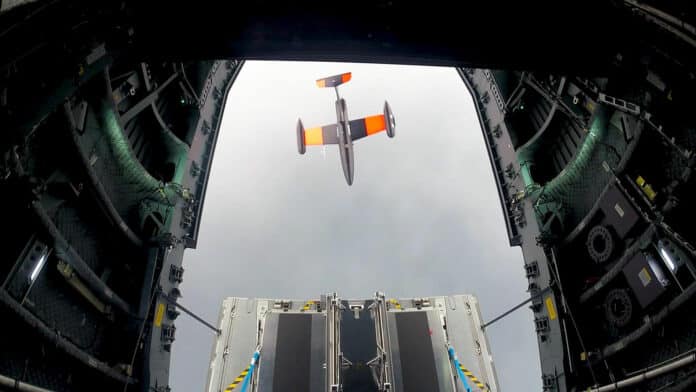Airbus has carried out the world’s first successful launch and operation of a Remote Carrier flight test demonstrator, a modified Airbus Do-DT25 drone, from a flying A400M. Jointly developed with Germany’s Bundeswehr, the German Aerospace Center DLR, and German companies SFL and Geradts, the project aims to supplement the upcoming European sixth-generation fighter jet, part of the Future Combat Air System (FCAS). Multiplying the force and extending the range of unmanned systems will be one of the future roles of Airbus’ military transport aircraft in the FCAS.
Developed in just six months, the demonstrator has been launched from the cargo hold of a flying A400M Atlas transport aircraft, demonstrating the ability that is expected to be routine for future loyal wingmen. After the release, the Do-DT25’s engines were started, and it continued in powered flight mode. The crew on board the A400M then handed over control to an operator on the ground, who safely commanded and landed the drone.
“The excellent collaboration with our German customer and partners on the A400M UAV Launcher campaign is further evidence of how the development of FCAS will take innovation and technologies to the next level,” said Airbus Defence and Space CEO Michael Schoellhorn. “FCAS as a system of systems is starting to take shape now.”
Remote Carriers have always been portrayed as a part of the FCAS program. Remote Carriers will fly in close cooperation with manned aircraft and support pilots in their tasks and missions. Military transport aircraft such as the A400M will play an important role – as motherships; they will bring the Remote Carriers as close as possible to their areas of operation before releasing up to 50 small or up to 12 heavy Remote Carriers. These will then join manned aircraft, operating with a high degree of automation, although always under a pilot’s control.
To get the A400M UAV Launcher ready for the test campaign, Airbus and its partners applied new ways of working, such as rapid prototyping and a joint flight testing approach. This enabled the multidisciplinary team to develop and integrate the system, bringing it into the needed systems-of-systems context in a very short time, ready for flight testing.
